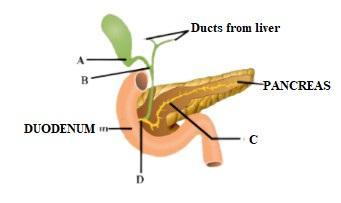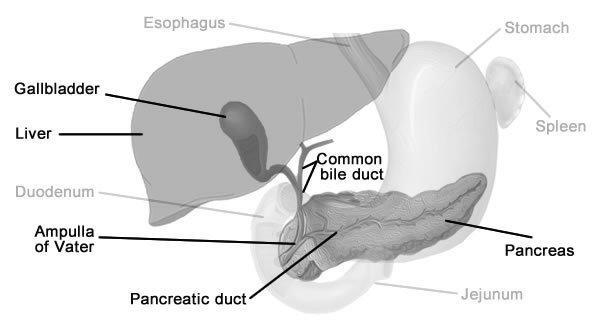
The given diagram shows a duct of the liver, gallbladder, and pancreas. Write the names of the duct from A to D

A) A-Cystic duct B-Common bile duct C-Pancreatic duct D-Hepato -pancreatic duct.
B) A-common bile duct B-Cystic duct C- Pancreatic duct C- Hepato Pancreatic duct.
C) A-Cystic duct B-Bile duct C-Pancreatic duct D-Hepato pancreatic duct.
D) A-Cystic duct B-Pancreatic duct C-Common bile duct D-Hepato pancreatic duct.

Answer
440.4k+ views
Hint: In biology, ducts stand for any tube, pipe, or Kendall by which a particular fluid, air, or other substances is conducted. There are mainly three types of ducts, the first one is conditional air duct Second one is recirculating air ducts and the third one is fresh air ducts.
Complete answer:
In the given diagram, the correctly marked parts are A-Cystic duct B-Common bile duct C-Pancreatic duct D-Hepato -pancreatic duct.

Figure: The different ducts in the liver, pancreas, and Gallbladder
Considering the marked parts one by one:
The cystic duct is connected to the top of the gallbladder’s Neck common hepatic duct, which meets the pancreatic duct before it empties into the duodenum as shown in the question’s figure.
Common bile duct carries bile from the liver and gallbladder through the pancreas and into the duodenum. It is formed where the duct and gallbladders are joined.
The pancreatic duct empties the secretions of the pancreas into the duodenum. The head of the pancreas is on the right side of the abdomen and is connected to the duodenum through a small tube as shown in the figure.
The hepatopancreatic duct is also known as the ampulla of Vater. It is formed when the common bile duct and the pancreatic duct combines.
Therefore from the given options above, the most appropriate answer is A. That is the correctly marked parts are A-Cystic duct B-Common bile duct C-Pancreatic duct D-Hepato -pancreatic duct.
Note:
The hepatic system, as well as other tracts of the digestive system, consists of the various sphincters in the openings. These are made up of muscles. It helps in the opening and closing at the end of different organs such as the stomach and intestines, and thereby regulates the movement of the food materials within.
Complete answer:
In the given diagram, the correctly marked parts are A-Cystic duct B-Common bile duct C-Pancreatic duct D-Hepato -pancreatic duct.

Figure: The different ducts in the liver, pancreas, and Gallbladder
Considering the marked parts one by one:
The cystic duct is connected to the top of the gallbladder’s Neck common hepatic duct, which meets the pancreatic duct before it empties into the duodenum as shown in the question’s figure.
Common bile duct carries bile from the liver and gallbladder through the pancreas and into the duodenum. It is formed where the duct and gallbladders are joined.
The pancreatic duct empties the secretions of the pancreas into the duodenum. The head of the pancreas is on the right side of the abdomen and is connected to the duodenum through a small tube as shown in the figure.
The hepatopancreatic duct is also known as the ampulla of Vater. It is formed when the common bile duct and the pancreatic duct combines.
Therefore from the given options above, the most appropriate answer is A. That is the correctly marked parts are A-Cystic duct B-Common bile duct C-Pancreatic duct D-Hepato -pancreatic duct.
Note:
The hepatic system, as well as other tracts of the digestive system, consists of the various sphincters in the openings. These are made up of muscles. It helps in the opening and closing at the end of different organs such as the stomach and intestines, and thereby regulates the movement of the food materials within.
Recently Updated Pages
Can anyone list 10 advantages and disadvantages of friction

What are the Components of Financial System?

How do you arrange NH4 + BF3 H2O C2H2 in increasing class 11 chemistry CBSE

Is H mCT and q mCT the same thing If so which is more class 11 chemistry CBSE

What are the possible quantum number for the last outermost class 11 chemistry CBSE

Is C2 paramagnetic or diamagnetic class 11 chemistry CBSE

Trending doubts
The correct order of melting point of 14th group elements class 11 chemistry CBSE

One Metric ton is equal to kg A 10000 B 1000 C 100 class 11 physics CBSE

What is the specific heat capacity of ice water and class 11 physics CBSE

State the laws of reflection of light

Proton was discovered by A Thomson B Rutherford C Chadwick class 11 chemistry CBSE

Why does niobium have a d4s1 electron configuration class 11 chemistry CBSE




